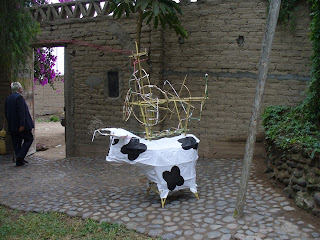 |
| (Photo by Daniel) |
On Saturday afternoon, the entire family and guests were driven about 78 kms north of Lima along the PanAmerican Highway in two buses and several personal cars, to Chacra y Mar, near the town of Chancay. The purpose for the trip was to celebrate Sara and Ted's marriage.
The site selected for the festivities was the Casa Darenas, some family's rambling country home, surrounded by mandarine orchards, which is now sometimes rented out for events. The house sits on a bluff within sight and sound of the sea, and has room for thirty guests to sleep in beds, and several more on the numerous couches and armchairs. The place itself was beautiful, and an inspired choice for the event, despite the added difficulties due to the distance from Lima.
I was so focused on greeting relatives whom I had not seen in years that I didn't take many pictures on the first day there, other than of the wedding itself - which I won't post here (I'll let Sara take care of that via her Facebook or elsewhere).
Nonetheless, here are some details:
 |
| The chapel |
 |
| Sara selected an Andean theme for the wedding |
 | |||
| Detail of the house's decor |
The party afterward was a lot of fun. Lots of good food, open bar, music, and dancing. It was great to catch up with relatives I hadn't seen in forever -some since I left Peru when I was but a kid, and some I only knew via internet.
Sometime after midnight Ted's groomsmen stripped down to their shorts and jumped into the pool. It was cold so they didn't stay in long!
For the second day of celebrations, Sunday, Sara had organized a pachamanca for the immediate family and selected guests -still close to 100 people. Pachamanca is ancient cooking method from Peru's central Andes -including Ayacucho, where our family is from- in which meat and tubers are cooked in a stone and earth "oven" in the ground. The word pacha is Quechua for the "earth", and manca is "pot" or "cooking vessel". Thus pachamanca literally means "earth pot".
Pachamancas come in several "flavors" -e.g. "three-flavored"or "five-flavored"- according to the number of meats being cooked. The particular combination of meats, and adjuncts, can vary according to regional tastes and customs, as do the seasonings and herbs used in the cooking. For this event a friend from Ayacucho was hired to do the pachamanca.
(I paid close attention to the process as Liz and I hope to some day host one of these in our backyard.)
To create the proper festive mood, a band had been hired, and fireworks purchased, including a vaca loca or "crazy cow".
 |
The "crazy cow"
First, the crew dug shallow pits in the ground and stacked bricks around them. Fires were built inside the towers and stoked for several hours.
Normally stones are used, but those must be carefully selected to not contain any sulphur or other compounds which could impart off-flavors, and must be such that they will retain heat adequately and not burst in the fire. Such are not always easy to find in a given location, so these days -specially in the cities- bricks are often used instead.
Normally stones are used, but those must be carefully selected to not contain any sulphur or other compounds which could impart off-flavors, and must be such that they will retain heat adequately and not burst in the fire. Such are not always easy to find in a given location, so these days -specially in the cities- bricks are often used instead.
As cooking time approached, the bricks were "cleaned" by whisking them sprigs of herbs.

When it was time to start cooking, the upper brick were removed, leaving a shallow ring inside the hole. The embers were removed, and the floor of the oven lined with cool bricks. The meats were placed in the hole, with layers of fresh alfalfa in between each layer-first, lamb, then pork, and lastly, chicken. The alfalfa used in this instance was there because it helps keep up the humidity inside the oven, but does not contribute any flavor.
As the layers built up, heated bricks were added to build up the oven. "Gato", the pachamanquero, explained that because bricks were being used the meats were wrapped in banana leaves. When the proper stones are used, the meats can be deposited directly on a bottom layer of heated rocks with herb sprigs.
After the meats, a layer of potatoes was added.
Next, a net bag of fava beans, and on top of that a layer of sweet tamal-like humitas, followed by a final thick layer of alfalfa.
After the foodstuffs had been all added, the whole thing was covered with wet cloths and the dirt removed in digging the hole. Finally, as custom requires, each of the two mounds was topped with a flower-decorated cross.
When the time comes for the pachamanca to be opened -after 1.5 to 2 hours- there is a specific ritual to be followed, if the thing is to be done right according to Ayacuchano custom.
First, the padrinos each take hold of the cross and lift it out of the ground. Padrino is generally translated as "godparent" (literally it is "godfather"; the female form is madrina), but in festivities it is taken to mean something closer to "sponsor" and is sometimes given to honored guests, even though they may not literally be the sponsors of the feast. Ted's parents acted as padrinos for one of the pachamancas, and my dad and my mom's friend, Margaret, did so for the second.
Next, the padrinos offer chicha or beer to the Pachamama, mother earth. Then, together, they remove the first shovelfuls of dirt from the pachamanca.
... and more fireworks...
... including the "crazy cow"...
















No comments:
Post a Comment